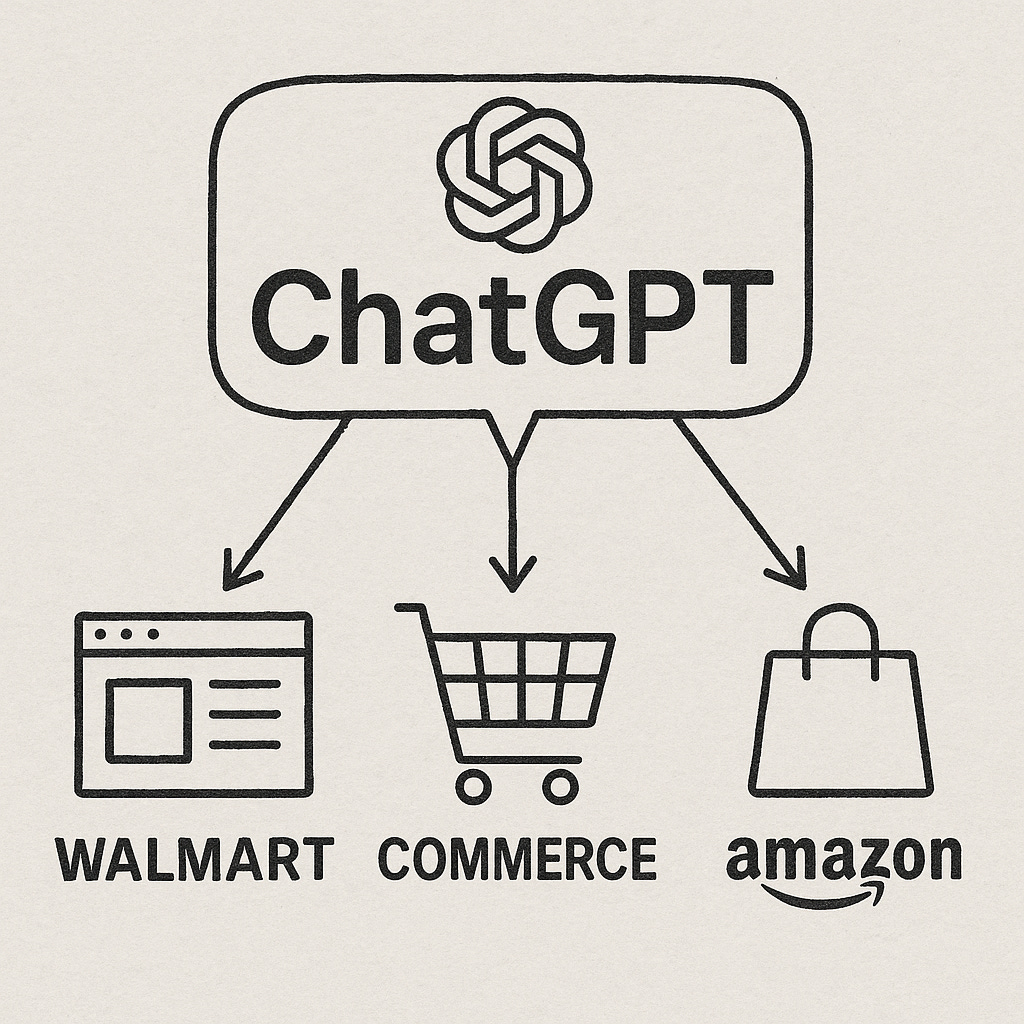The Rise of Commerce on ChatGPT
Why OpenAI Is Now a Key Distribution Channel
When I first wrote about ChatGPT to Commerce a few months ago, I framed the shift as speculative — a future possibility. But the data is catching up fast: ChatGPT is now a top-tier traffic source for major retailers. Walmart reports that 20% of its referral clicks now originate from ChatGPT, up from 15% just one month prior. (Modern Retail) Meanwhile, OpenAI has introduced Instant Checkout and the Agentic Commerce Protocol, enabling users to make purchases directly in chat. (OpenAI)
That means the question isn’t whether ChatGPT will matter for commerce — it already does. The real question for product and growth leaders is: How do we become visible, trusted, and loved inside someone else’s conversation? OpenAI is becoming a distribution channel in its own right — and if your product, catalog, or commerce strategy doesn’t account for that, you’re opting out of the mainstream future.
1. Referral Growth Signals Intent, Not Novelty
The first wave of traffic lifts isn’t a novelty bump — it’s a signal of consumer intent. Walmart’s numbers are staggering: one in five referral clicks came from ChatGPT in August, with Target, Etsy, and eBay also seeing measurable lifts.
This growth is organic and bottom-up. Unlike paid search or display ads, you’re not buying your way into this channel. Users are leaning into ChatGPT to help them decide what to buy. That’s a strong early sign of durable behavior change — and a huge opportunity for those who adapt quickly.
2. From “Search → Site → Cart” to “Conversation → Buy”
OpenAI’s Instant Checkout reshapes the entire transaction flow. A user can now:
Ask ChatGPT for a recommendation.
Get a specific product suggestion.
Tap “Buy” inside the chat.
Confirm payment and shipping.
No browser tabs. No endless checkout forms. No bouncing between comparison sites.
And because the Agentic Commerce Protocol is an open standard, merchants can integrate their existing backends seamlessly while OpenAI provides the connective layer. This isn’t replacing e-commerce websites — it’s collapsing the distance between discovery and conversion.
3. Visibility in AI Context = A New Type of Ranking
In Google, SEO and ads determine discoverability. In ChatGPT, visibility is far more opaque. Your product’s presence depends on:
How well your catalog integrates with the Agentic Commerce Protocol.
What training data the model has seen.
How recommendations are weighted within a conversation.
This means classic SEO playbooks don’t apply. Instead, success will come from ensuring your products are structured, accessible, and optimized for AI-first retrieval. Think of it less as “ranking for keywords” and more as “earning trust from a model.”
4. Business Model: From Free Traffic to Transaction Margins
Right now, referral traffic from ChatGPT is free. But OpenAI has already signaled its monetization approach: a small fee per completed transaction.
This is significant. Unlike Google or Amazon, where visibility is often pay-to-play, OpenAI isn’t charging for placement (at least not yet). Instead, it monetizes on the backend — a take rate on the transaction. This sets up a different power dynamic:
Merchants save on acquisition costs compared to traditional paid channels.
OpenAI becomes the gatekeeper of checkout flows and consumer data.
Competition shifts from ad bidding to integration quality and trustworthiness.
5. Your Competitive Wedge Shifts Post-Transaction
Perhaps the most important shift: once the transaction happens inside ChatGPT, you lose control of the front-end funnel. There’s no homepage to showcase your brand, no crafted checkout flow to upsell, no chance to tell your story.
That means your competitive wedge moves downstream:
Retention becomes the moat: loyalty programs, subscriptions, and reorders.
Post-purchase experience is the differentiator: fulfillment, customer support, and follow-ups.
Direct relationships matter more: capturing consent for email, SMS, or app engagement is critical.
The challenge is clear: you may not control how the user discovers you, but you can absolutely control how they remember you.
Closing Thoughts
In 2023, “commerce inside ChatGPT” sounded like a thought experiment. By mid-2025, it’s here — and scaling fast. If ChatGPT already accounts for 20% of Walmart’s referral traffic, it’s no longer a fringe channel. It’s becoming a distribution venue with its own rules, economics, and consumer behaviors.
For product leaders, growth teams, and commerce operators, the next question is strategic: How do we adapt our catalog, integrations, and post-purchase relationships to thrive in an AI-first distribution world?
The companies that treat OpenAI as just another channel will play catch-up. The ones that treat it as a platform will build enduring advantages.
Key Takeaways:
ChatGPT is already a top referral source for major retailers.
Instant Checkout and Agentic Commerce Protocol collapse the distance between discovery and purchase.
Visibility in AI contexts is opaque and requires new playbooks beyond SEO.
OpenAI monetizes on transaction fees, not placement — shifting the economics of acquisition.
Your moat moves post-transaction: retention, experience, and direct relationships matter more than ever.

